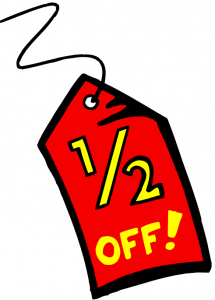 Pricing is a hard topic to deal with systematically. Especially for small companies without a lot of data to crunch. I’m preparing for a pricing session with a client, and thought I’d share a little with you here.
Pricing is a hard topic to deal with systematically. Especially for small companies without a lot of data to crunch. I’m preparing for a pricing session with a client, and thought I’d share a little with you here.
We’re using principles laid out in the book The 1% Windfall by Rafi Mohammed. The title comes from the idea that if a company can increase prices by 1% and keep costs the same they will reap a windfall. BUT what’s counter-intuitive is that you don’t just jack prices up across the board. Mohammed provides over four dozen pricing tactics, some of which involve actually lowering prices.
The goal is to use pricing to capture as much revenue across all spectrums of customers by appealing to what they are willing to pay – and by doing so raise your prices by 1% while keeping costs the same. For example, did you know Starbucks (the company famous for calling their small size tall) actually has a 4th size? In addition to Tall, Venti and Grande (that’s small medium and large to you and me) they have a size called SHORT? It’s not on the menu, but if you ask for it, you’ll get it in every Starbucks. That way they can capture extra revenue from some folks without broadcasting to everyone that they have an “extra small” size.
I don’t have room to go over every aspect of my session here but I will give you three points. These are inspired by the book, but I’ve added a twist or two.
#1 – Customers pay for value as they perceive it.
Before you can start any pricing strategy, you must understand value from your customer’s point of view. And not all customers value the same things. By appealing to different aspects of value, you can set different prices for different customers and capture more sales and more profit.
You are somewhat familiar with how airlines do this. Every time they make a sale they sell the same product (a seat in a metal tube that goes from point A to point B). But prices change based on other things that customers value. Things such as how far in advance to buy the ticket, if it’s refundable or not, if it requires a round trip or a Saturday night say etc.
#2 – All Sales are emotional.
Even the most sharp penciled CFO who eats and sweats spreadsheets is emotionally involved in getting value for their money. And you can benefit from appealing to that emotion as well as to logic.
#3 – The point of pricing is profit not revenue.
Your pricing structure as well as related policies (like your sales commission structure, when to give discounts and what to get in exchange for them) must be developed to maximize profit. Your bottom line is more important than your top line.
Takeaways:
1. Read the book.
2. Institute a pricing strategy based on the customer’s calculation of value and your calculation of profit.
3. Call me if you need help with #2